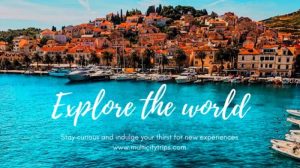
Exploring the world is a dream for many, and for Indian citizens, a valid passport opens doors to numerous visa-free destinations. This guide delves into the exciting possibilities, outlining countries accessible without visa hassles, essential passport requirements, and practical tips for a smooth and memorable journey. We’ll cover everything from finding the cheapest flights to packing efficiently, ensuring your trip is both affordable and enjoyable.
Understanding visa-free travel is crucial for Indian citizens planning international trips. This involves knowing which countries allow entry without a prior visa application, the necessary passport validity, and any additional documentation requirements. Beyond the logistics, we’ll also touch upon travel insurance, photography tips, and cultural sensitivity, aiming to provide a holistic travel experience.
Visa-free Countries for Indian Citizens
Traveling internationally can be an exciting prospect, and knowing which countries you can visit without the hassle of a visa beforehand significantly simplifies the planning process. This information is crucial for Indian citizens looking to explore the world. Please note that visa requirements can change, so always verify the latest information with the respective embassy or consulate before your trip.
The following table details countries offering visa-free or visa-on-arrival access to Indian passport holders. It’s essential to check the specific requirements for each country, as conditions such as minimum passport validity and purpose of visit can impact entry.
Visa-free Countries for Indian Citizens: A Detailed Overview
The information below is for guidance only and should not be considered exhaustive. Always consult official government sources for the most up-to-date details.
| Country | Visa Requirement | Passport Validity | Additional Notes |
|---|---|---|---|
| Nepal | Visa-free | Minimum 6 months validity | No additional documentation usually required. |
| Bhutan | Visa on arrival (pre-arranged permit required) | Minimum 6 months validity | Requires pre-arranged permit through a licensed Bhutanese tour operator. |
| Maldives | Visa on arrival | Minimum 6 months validity | Generally straightforward; may require proof of onward travel. |
| Mauritius | Visa on arrival | Minimum 6 months validity | Requires proof of onward/return ticket and sufficient funds. |
| Seychelles | Visa on arrival | Minimum 6 months validity | Similar to Mauritius, proof of onward travel and sufficient funds are typically required. |
| Indonesia | Visa on arrival (for tourism) | Minimum 6 months validity | Specific requirements may apply depending on the length of stay. |
| Jamaica | Visa on arrival | Minimum 6 months validity | May require proof of onward travel and accommodation. |
| Fiji | Visa on arrival | Minimum 6 months validity | Proof of onward travel and sufficient funds are usually needed. |
| Haiti | Visa on arrival | Minimum 6 months validity | Requirements may vary; check with the Haitian embassy or consulate. |
| Bolivia | Visa on arrival (for tourism, for a limited duration) | Minimum 6 months validity | Specific requirements may apply depending on the length of stay. |
Travel Hacks for Indian Citizens
Planning a trip to a visa-free destination can be exciting, but it’s crucial to strategize for cost-effective and efficient travel. This section offers practical tips for Indian citizens to maximize their travel experience while minimizing expenses and hassle. These hacks focus on pre-trip planning, in-flight comfort, and smart spending during your journey.
Cost-Saving Strategies for International Travel
Careful planning is key to saving money on your trip. Consider traveling during the off-season or shoulder season (the periods between peak and off-season) to benefit from lower airfares and accommodation costs. For example, visiting Southeast Asia during the monsoon season might mean rain showers, but you’ll encounter significantly lower prices than during the peak tourist months. Similarly, booking flights and accommodation well in advance often leads to better deals, allowing you to secure your preferred options at a lower cost.
Utilizing price comparison websites and setting up price alerts can also help you track fare fluctuations and snag the best deals. Finally, explore budget-friendly accommodation options like hostels, guesthouses, or Airbnb, which can drastically reduce your overall lodging expenses.
Finding the Cheapest Flights to Visa-Free Destinations
Finding the cheapest flights requires a multi-pronged approach. Start by using flight comparison websites like Skyscanner, Google Flights, Kayak, and Momondo. These websites aggregate flight information from various airlines and travel agencies, allowing you to compare prices easily. Be flexible with your travel dates; often, shifting your departure or return by even a day or two can significantly impact the price.
Consider flying mid-week (Tuesday or Wednesday) as these days typically offer lower fares than weekends. Furthermore, flying into smaller, less popular airports near your destination might offer cheaper options. For instance, instead of flying directly into London Heathrow, consider flying into Gatwick or Stansted, which might offer lower fares. Finally, remember to factor in baggage fees; choosing a budget airline might seem cheaper initially, but hefty baggage charges can quickly negate the savings.
Packing Light and Efficiently for International Travel
Packing light not only saves you money on baggage fees but also simplifies your travel experience. Create a packing list well in advance and stick to it. Choose versatile clothing items that can be mixed and matched to create multiple outfits. Opt for neutral colors that coordinate easily. Roll your clothes instead of folding them to save space and minimize wrinkles.
Utilize packing cubes to organize your belongings and compress your clothing. Remember to check the weather forecast for your destination and pack accordingly. Avoid overpacking toiletries; instead, purchase travel-sized containers or utilize solid toiletries to reduce weight and volume. Remember to leave some space in your bag for souvenirs!
Travel Insurance for International Trips
Embarking on an international trip, especially to a visa-free country, can be an exciting adventure. However, unforeseen circumstances can arise, impacting your travel plans and potentially leading to significant financial burdens. Securing comprehensive travel insurance is crucial to mitigate these risks and ensure peace of mind throughout your journey. It provides a safety net against unexpected events, protecting you from potentially devastating costs.Travel insurance offers a vital safeguard against a range of potential problems that can arise during international travel.
It’s an investment in your trip’s safety and security, offering protection beyond what your existing health insurance might cover. Failing to have adequate insurance could result in substantial out-of-pocket expenses in the event of an emergency.
Types of Travel Insurance Plans and Coverage
Travel insurance plans vary considerably in their coverage and price. Understanding the different types available allows you to choose a policy that best suits your needs and budget. Key differences lie in the extent of medical coverage, baggage protection, and trip cancellation provisions.
- Basic Plans: These plans typically offer essential coverage for medical emergencies and trip cancellations or interruptions due to unforeseen circumstances like severe weather. Baggage loss coverage is often limited.
- Standard Plans: Standard plans provide broader coverage than basic plans, including increased medical expense limits, more comprehensive baggage coverage (including loss, theft, and damage), and potentially coverage for things like flight delays or missed connections.
- Comprehensive Plans: These plans offer the most extensive coverage, encompassing all aspects of the standard plans, plus additional benefits such as emergency medical evacuation, repatriation of remains, and potentially even coverage for adventure activities or pre-existing conditions (subject to specific policy terms and conditions).
Examples of Situations Where Travel Insurance is Beneficial
Numerous situations can arise where travel insurance proves invaluable. The peace of mind it provides is worth the investment.
- Medical Emergencies: Medical expenses abroad can be extraordinarily high. Travel insurance covers costs associated with hospitalization, doctor visits, emergency medical evacuation, and repatriation. For instance, a simple broken bone treated in a foreign hospital could easily cost thousands of dollars without insurance.
- Lost or Stolen Luggage: Losing your luggage can disrupt your trip and incur significant expenses replacing essential items. Travel insurance compensates for lost or stolen baggage, covering the cost of replacing necessary clothing, toiletries, and other personal belongings.
- Trip Cancellation or Interruption: Unexpected events, such as severe weather, family emergencies, or sudden illness, can necessitate trip cancellation or interruption. Travel insurance can reimburse non-refundable expenses such as flights, accommodation, and tours.
- Flight Delays or Missed Connections: Unexpected delays can lead to additional expenses for accommodation and meals. Some comprehensive travel insurance policies offer coverage for such situations.
Travel Photography Tips
Capturing stunning travel photographs is a crucial part of preserving memories and sharing the beauty of your visa-free adventures. This section offers practical tips and techniques to elevate your travel photography, regardless of your skill level or the environment you’re shooting in. By understanding the basics of composition, lighting, and equipment, you can transform ordinary snapshots into captivating images that tell the story of your journey.Mastering travel photography involves understanding light, composition, and your equipment.
The time of day, the angle of the sun, and even the weather all significantly impact the quality of your photographs. Similarly, thoughtful composition – considering the rule of thirds, leading lines, and negative space – can transform a mundane scene into a compelling image. Finally, having the right gear can make a world of difference, allowing you to adapt to various shooting conditions and capture the details that truly matter.
Essential Photography Equipment for Travel
Choosing the right equipment is key to capturing high-quality travel photos. A lightweight and versatile kit is ideal for navigating diverse locations and minimizing baggage. Prioritizing durability and ease of use is also crucial, especially when exploring less accessible areas.
- Camera: A mirrorless camera or a high-quality point-and-shoot camera offers a balance of image quality and portability. Consider cameras with interchangeable lenses for added versatility.
- Lenses: A versatile zoom lens (e.g., 24-70mm or 18-55mm) is a great starting point, allowing you to capture both wide shots and detailed close-ups. A wider-angle lens (e.g., 16-35mm) is beneficial for landscapes and cityscapes, while a telephoto lens (e.g., 70-200mm) is ideal for wildlife or distant subjects.
- Tripod: A lightweight and sturdy tripod is essential for sharp images in low-light conditions or when using longer exposures. It also provides stability for capturing time-lapses or panoramic shots.
- Accessories: Extra batteries, memory cards, a lens cleaning kit, and a camera bag are vital for maintaining your equipment and ensuring you’re prepared for any situation. Consider a polarizing filter to reduce glare and enhance colors, and a neutral density (ND) filter for controlling light in bright conditions.
Techniques for Diverse Environments
Adapting your photography techniques to different environments is crucial for capturing memorable images. Cityscapes, landscapes, and portraits each require a unique approach to achieve the best results.
- Cityscapes: Capture the energy and vibrancy of cities by focusing on architectural details, street life, and unique perspectives. Experiment with different angles and compositions to showcase the city’s character. Consider shooting during the golden hour (sunrise or sunset) for warm, inviting light.
- Landscapes: Emphasize the scale and grandeur of natural landscapes by using wide-angle lenses and incorporating leading lines to guide the viewer’s eye. Pay attention to the sky and clouds, as they can significantly impact the mood and atmosphere of your photographs. Consider using a tripod for sharp images, especially in low-light conditions.
- Portraits: Capture the essence of people you meet during your travels. Interact with your subjects, build rapport, and capture candid moments that reveal their personality. Use a shallow depth of field (wide aperture) to blur the background and emphasize the subject. Consider using natural light for a more flattering and authentic look.
Travel Tips for Visa-Free Destinations

Embarking on a journey to a visa-free country is exciting, but careful planning ensures a smooth and enjoyable trip. This section provides essential tips for Indian citizens, focusing on safety and cultural sensitivity to help you navigate your travels with confidence. Remember, respecting local customs and laws is paramount to a positive experience.
Safety Precautions in Visa-Free Countries
Prioritizing safety is crucial when traveling abroad. Being aware of your surroundings and taking proactive measures can significantly reduce the risk of incidents. This section Artikels key safety considerations for Indian citizens visiting visa-free destinations.
- Register with the Indian Embassy: Inform the Indian embassy or consulate in your destination country of your travel plans. This step allows them to assist you in case of emergencies.
- Copy Important Documents: Make copies of your passport, visa (if applicable), tickets, and other crucial documents. Store these copies separately from the originals. Consider scanning them and storing them in a cloud-based service as an added precaution.
- Be Aware of Your Surroundings: Stay vigilant and avoid walking alone in poorly lit or isolated areas, especially at night. Be mindful of your belongings in crowded places.
- Use Reputable Transportation: Opt for official taxis or ride-sharing services instead of unofficial transportation. Share your location with trusted contacts.
- Learn Basic Self-Defense: Familiarize yourself with basic self-defense techniques, which can be helpful in unexpected situations. Consider taking a self-defense class before your trip.
Cultural Sensitivity and Etiquette
Understanding and respecting the local culture is vital for a positive travel experience. This section highlights key cultural considerations for Indian citizens traveling to visa-free destinations.
- Research Local Customs: Before your trip, research the customs and traditions of your destination. Understanding local etiquette will prevent unintentional offenses.
- Dress Appropriately: Dress modestly, especially when visiting religious sites or conservative areas. Check local guidelines for appropriate attire before packing.
- Learn Basic Phrases: Knowing a few basic phrases in the local language can go a long way in showing respect and facilitating communication. (See below for examples).
- Respect Religious Practices: Be mindful of religious practices and traditions in your destination. Avoid actions that could be considered disrespectful.
- Bargaining: In some cultures, bargaining is expected in markets. However, be respectful and polite during the process.
Essential Phrases in Local Languages
Learning a few basic phrases can greatly enhance your interactions with locals. While this cannot cover all languages, these examples provide a starting point for common situations. Remember to pronounce words carefully and respectfully.
Hello: (Examples: Hola – Spanish, Bonjour – French, Namaste – Hindi/Sanskrit, Sawasdee – Thai)Thank you: (Examples: Gracias – Spanish, Merci – French, Shukriya – Hindi/Urdu, Khop Khun – Thai)Excuse me: (Examples: Disculpe – Spanish, Excusez-moi – French, Maf karit – Hindi, Khot thod – Thai)Please: (Examples: Por favor – Spanish, S’il vous plaît – French, Kripya – Hindi, Krap/Ka – Thai)Yes/No: (Examples: Sí/No – Spanish, Oui/Non – French, Haan/Nahin – Hindi, Chai/Mai Chai – Thai)Help!: (Examples: ¡Ayuda!
- Spanish, Au secours!
- French, Madad karo!
- Hindi, Chuay duay!
- Thai)
Travel Visa Information for Other Destinations
Securing a visa for travel to countries that require them for Indian citizens can be a complex process, but understanding the steps involved and the potential challenges can greatly improve your chances of success. This section provides an overview of the visa application process, comparing fees and processing times for different countries, and offering tips for a smoother application.The visa application process generally involves gathering required documents, completing an application form, paying the visa fee, and attending an interview (in some cases).
The specific requirements vary significantly depending on the country you’re visiting and the type of visa you need (tourist, business, student, etc.). It’s crucial to check the specific requirements on the official website of the respective country’s embassy or consulate in India well in advance of your planned travel dates.
Visa Application Process for Various Countries
The process usually begins with identifying the correct visa type for your purpose of travel. Then, you’ll need to gather the necessary documentation, which often includes a completed application form, passport photos, proof of financial means, itinerary details, and a copy of your passport. Many countries now offer online application portals, simplifying the process. However, some still require in-person submissions.
After submitting your application, you’ll typically need to wait for processing, which can range from a few days to several weeks or even months, depending on the country and the volume of applications. You may also be required to attend an interview at the embassy or consulate.
Comparison of Visa Application Fees and Processing Times
Visa fees and processing times vary considerably. For example, a Schengen visa (allowing travel within the Schengen Area of Europe) might cost around €80 and take several weeks to process, while a visa for the United States could cost more and have a longer processing time. A tourist visa for some countries in Southeast Asia might be significantly cheaper and processed faster.
It’s essential to check the specific fees and processing times on the official website of the relevant embassy or consulate as these are subject to change. For instance, a UK visitor visa can range from £95 to £1000, and processing times are often impacted by seasonal fluctuations in applications.
Tips for a Successful Visa Application
Thorough preparation is key to a successful visa application. Ensure all documents are accurately completed and submitted. Provide clear and concise answers to all questions on the application form. Be honest and accurate in all information provided. If you are applying for a tourist visa, include detailed information about your travel plans, such as a confirmed flight and hotel booking.
For business visas, ensure that you have a clear purpose for your trip. If required, be prepared to attend an interview at the embassy or consulate. Presenting yourself professionally and answering questions confidently will enhance your chances of approval. Finally, allow ample time for the application process, especially for countries with longer processing times. Leaving enough time before your travel date will reduce stress and increase your chances of success.
Urban Escapes in Visa-Free Countries
For Indian citizens with a valid passport, several exciting urban destinations offer visa-free entry, providing a wealth of cultural experiences and travel opportunities. These cities boast diverse attractions, from historical landmarks to vibrant modern scenes, catering to a wide range of interests. Exploring these urban hubs allows for immersive travel experiences without the complexities of visa applications.Exploring these dynamic cities provides a unique blend of history, culture, and modern life, allowing for a richer travel experience.
The following table highlights some popular choices, considering factors like ease of access, cultural richness, and safety for Indian travelers.
Popular Urban Destinations for Indian Travelers
| City | Country | Activities | Recommended Duration |
|---|---|---|---|
| Bangkok | Thailand | Explore magnificent temples like Wat Arun and Wat Pho, experience the vibrant nightlife of Khao San Road, indulge in delicious street food, take a boat trip along the Chao Phraya River, visit bustling markets like Chatuchak Weekend Market. | 5-7 days |
| Singapore | Singapore | Visit Gardens by the Bay, explore the vibrant cultural districts like Little India and Chinatown, enjoy the stunning views from the Marina Bay Sands, experience the diverse culinary scene, visit the iconic Merlion statue. | 4-6 days |
| Kuala Lumpur | Malaysia | Visit the iconic Petronas Twin Towers, explore the Batu Caves, experience the vibrant street art scene in Bukit Bintang, indulge in delicious Malaysian cuisine, visit the Merdeka Square. | 4-5 days |
| Malé | Maldives | Explore the bustling capital city, visit the National Museum, enjoy the vibrant local markets, relax on the beautiful beaches nearby, experience the underwater world through snorkeling or diving excursions. Note that while Malé itself is an urban center, the main draw of the Maldives is its island resorts. | 2-3 days (as a base for island hopping) |
| Dubai | UAE | Visit the Burj Khalifa, explore the Dubai Mall, experience the vibrant souks (markets), enjoy the stunning architecture, visit the Palm Jumeirah, experience desert safaris. | 5-7 days |
Vacation Packages and Programs
Planning a trip to one of the many visa-free destinations available to Indian citizens can be exciting, but organizing the logistics can feel overwhelming. Fortunately, a range of vacation packages and programs cater to different budgets and travel styles, simplifying the process and ensuring a smoother experience. This section explores the various options available, highlighting their features and helping you make an informed decision.Exploring different types of vacation packages available for visa-free destinations reveals a wide spectrum of options tailored to individual preferences and budgets.
These packages often bundle flights, accommodation, and sometimes activities or excursions, offering a convenient and often cost-effective way to travel.
Types of Vacation Packages and Price Ranges
Vacation packages for visa-free destinations are incredibly diverse. Budget-friendly options, focusing on basic accommodation and flights, might start around ₹50,000 for a short trip to a nearby Southeast Asian country. Mid-range packages, including comfortable hotels and some included activities, can range from ₹100,000 to ₹250,000 depending on the destination and duration. Luxury packages, featuring five-star hotels, private transfers, and bespoke experiences, can easily exceed ₹500,000.
These price ranges are estimates and can vary significantly based on factors like travel dates, specific hotels, and the inclusion of activities. For example, a week-long trip to Bali might fall within the mid-range, while a similar trip to the Maldives could easily fall into the luxury category.
Booking Through Travel Agencies Versus Independent Travel
Choosing between booking a vacation package through a travel agency or independently involves weighing several factors. Travel agencies offer convenience, handling all aspects of the trip from flights and accommodation to visa assistance (where needed for other destinations) and travel insurance. However, they often come with higher costs due to their service fees. Independent booking, while requiring more effort in researching and coordinating individual elements, provides greater flexibility and control, potentially resulting in cost savings.
For example, you might find cheaper flights by booking directly with airlines and accommodation through platforms like Airbnb or Booking.com. However, independent travel requires more time and organizational skills.
Features of Various Vacation Programs
Several vacation programs cater to specific travel styles. All-inclusive resorts provide a hassle-free experience with meals, drinks, and activities included in the package price. This simplifies budgeting and eliminates the need for constant decision-making about dining and entertainment. Adventure tours, on the other hand, focus on outdoor activities such as trekking, hiking, or water sports, offering a more active and immersive travel experience.
These tours typically include experienced guides and necessary equipment. Cruises offer a unique way to explore multiple destinations without the hassle of constantly changing hotels. The cost varies significantly depending on the level of luxury and the duration of the cruise. For instance, a cruise to the Mediterranean could offer a diverse range of experiences, from exploring historical sites to relaxing by the pool, but the price would depend heavily on the cabin class and the length of the voyage.
Venture Capital and Travel (Indirect Relation)

Venture capital (VC) investment significantly shapes the travel industry, fueling innovation and transforming how we plan, book, and experience travel. The influx of capital supports the development of new technologies and business models, ultimately impacting accessibility, affordability, and the overall travel experience for consumers.The travel sector, traditionally characterized by established players, is undergoing a rapid digital transformation, largely driven by VC funding.
This investment is crucial for scaling disruptive startups and fostering competition, leading to a more dynamic and customer-centric market. The role of technology in this evolution is undeniable, with VC funding acting as the catalyst for progress.
Impact of Venture Capital on Travel Technology Innovation
Venture capital funding has been instrumental in developing innovative travel technologies. This investment allows startups to build and refine cutting-edge solutions, from sophisticated booking platforms to personalized travel planning tools and AI-powered travel assistants. The result is a more efficient and user-friendly travel experience, reducing friction and empowering travelers with greater control and choice. For example, the development of dynamic pricing algorithms, fueled by VC investment, allows for more competitive and responsive pricing strategies, benefitting both travelers and businesses.
Examples of Venture Capital-Backed Travel Companies
Several prominent travel companies have benefited from substantial venture capital funding. Airbnb, a platform revolutionizing accommodation booking, secured significant VC investment early in its development, enabling its rapid global expansion. Another example is Skyscanner, a flight comparison website, which leveraged VC funding to build its extensive database and sophisticated search algorithms. These examples illustrate the crucial role VC plays in scaling successful travel businesses.
Other companies, like Hopper (predictive travel pricing), and Oyo (budget-friendly hotels), have also seen substantial VC backing, further demonstrating the industry’s reliance on this funding source.
Technology’s Role in Enhancing Travel Accessibility and Affordability
Technology, empowered by venture capital, is making travel more accessible and affordable in several ways. Online booking platforms offer transparency and price comparison, enabling travelers to find the best deals. The rise of budget airlines and alternative accommodation options, facilitated by technological advancements and VC investment, has broadened travel opportunities for a wider range of budgets. Furthermore, the development of mobile travel apps provides travelers with on-the-go access to information, booking services, and real-time support, improving convenience and efficiency.
The integration of AI and machine learning in travel planning tools also promises to personalize travel recommendations and optimize itineraries, further enhancing the overall travel experience while reducing costs through optimized route planning and accommodation choices.
Embarking on a visa-free adventure from India is an exciting prospect, filled with the promise of new experiences and cultural immersion. By understanding the requirements, preparing meticulously, and embracing the spirit of exploration, Indian citizens can unlock a world of travel opportunities. Remember to prioritize safety, respect local customs, and capture the memories that will last a lifetime. Happy travels!
Questions Often Asked
What is the minimum passport validity required for most visa-free countries?
Generally, six months validity beyond your intended stay is recommended, though specific requirements vary by country.
Can I enter a visa-free country if my passport has damaged pages?
Damaged or heavily used passports may be rejected, even for visa-free countries. A passport in good condition is essential.
How many blank pages should my passport have?
Aim for at least two to four blank pages; some countries may require more for entry and immigration stamps.
What happens if I lose my passport while traveling?
Report the loss to local authorities immediately and contact your embassy or consulate for assistance in obtaining emergency travel documents.





